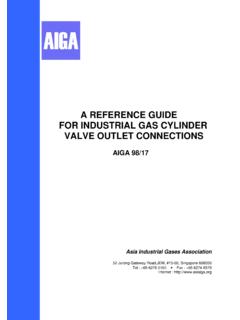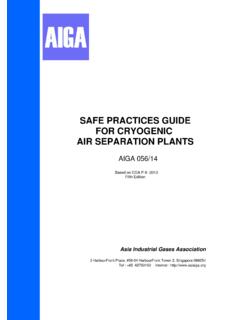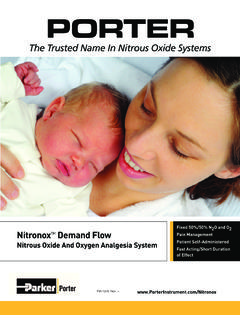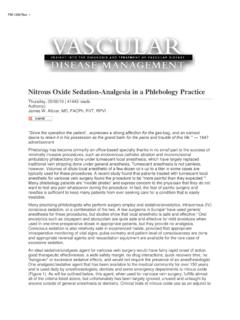Transcription of Clean Copy of AIGA 081 16 Safe Practices for …
1 SAFE Practices FOR storage AND handling OF nitrous oxide AIGA 081/16 Revision of AIGA081/13 Asia Industrial Gases Association 3 HarbourFront Place, #09-04 HarbourFront Tower 2, Singapore 099254 Tel : +65 62760160 Fax : +65 62749379 Internet : Reproduced with permission from the European Industrial Gases Association. All rights reserved. ASIA INDUSTRIAL GASES ASSOCIATION 3 HarbourFront Place, #09-04 HarbourFront Tower 2, Singapore 099254 Tel: +65 62760160 Fax: +65 62749379 Internet: AIGA 081/16 SAFE Practices FOR storage AND handling OF nitrous oxide As part of a programme of harmonization of industry standards, the Asia Industrial Gases Association (AIGA) has issued this publication 081, Safe Practices for the storage and handling of nitrous oxide , jointly produced by members of the International Harmonisation Council and originally published by the European Industrial Gases Association (EIGA), Safe Practices for the storage and handling of nitrous oxide .
2 This publication is intended as an international harmonized publication for the worldwide use and application by all members of Asia Industrial Gases Association (AIGA), Compressed Gas Association (CGA), EIGA, and Japan Industrial and Medical Gases Association (JIMGA). Each association s technical content is identical, except for regional regulatory requirements and minor changes in formatting and spelling. Disclaimer All publications of AIGA or bearing AIGA s name contain information, including Codes of Practice, safety procedures and other technical information that were obtained from sources believed by AIGA to be reliable and/ or based on technical information and experience currently available from members of AIGA and others at the date of the publication.
3 As such, we do not make any representation or warranty nor accept any liability as to the accuracy, completeness or correctness of the information contained in these publications. While AIGA recommends that its members refer to or use its publications, such reference to or use thereof by its members or third parties is purely voluntary and not binding. AIGA or its members make no guarantee of the results and assume no liability or responsibility in connection with the reference to or use of information or suggestions contained in AIGA s publications. AIGA has no control whatsoever as regards, performance or non performance, misinterpretation, proper or improper use of any information or suggestions contained in AIGA s publications by any person or entity (including AIGA members) and AIGA expressly disclaims any liability in connection thereto.
4 AIGA s publications are subject to periodic review and users are cautioned to obtain the latest edition. AIGA AIGA 081/16 Table of Contents 1 Introduction .. 1 2 Scope .. 1 3 Definitions .. 1 Publication terminology .. 1 Technical definitions .. 2 4 Properties and hazards .. 3 Identification .. 3 Physical properties and hazards .. 4 Chemical properties and hazards .. 6 Occupational exposure .. 10 Environmental 12 Security .. 12 5 Equipment and procedures .. 12 Principles .. 12 Compatibility of materials with nitrous oxide .. 13 Valves.
5 13 Filters .. 13 Cleaning of installation .. 14 Prevention of contamination .. 14 Avoiding high temperature .. 14 Restriction of flow velocity .. 15 Operating procedures .. 15 Maintenance procedures .. 15 Isolation from flammable gases .. 16 Use of carbon dioxide equipment .. 16 6 Stationary tanks .. 16 Design .. 16 Refrigeration units .. 18 Vaporizers and heaters .. 18 Piping, instrumentation, valves .. 19 Pressure relief valves .. 20 Admissible filling degree / filling 20 Filling of stationary low pressure 21 Product return.
6 21 7 Supply equipment .. 21 Cylinders .. 21 Bundles .. 22 Transport tanks .. 22 Pumps .. 23 Hoses, accessories and couplings (fill connections) .. 25 8 Product transfer .. 25 Cylinders and bundles .. 25 Transport tanks .. 26 9 Emergency response .. 28 Hazards .. 28 Procedures for large leaks or spills of nitrous oxide .. 28 Procedures at fire situations .. 28 Procedures at traffic incident involving a transport tank .. 29 Personal protective equipment (PPE) .. 30 First aid .. 31 AIGA 081/13 10 References .. 31 Figures Figure 1 Propagation threshold for nitrous oxide .
7 9 Figure 2 P & I diagram of a typical nitrous oxide vacuum insulated stationary tank .. 20 Figure 3 Safe filling volumes for 22 bar nitrous oxide storage tanks .. 27 Amendments to 081/13 Section Change Editorial to align style with IHC associations 1 Change to Introduction Addition of publications terminology Additional definition Change to section Reference to ACGIH added Additional point on security added Note: Technical changes from the previous edition are underlined AIGA 081/13 1 1 Introduction nitrous oxide (N2O) has been produced and distributed by the industrial gases industry for many years.
8 It is mainly used for medical purposes (anaesthesia). It is also used in the food and electronic industries. Accidents such as violent decomposition of nitrous oxide and the rupture of nitrous oxide tanks have occurred at production, storage and distribution facilities. In addition, nitrous oxide gas in elevated concentrations can cause health effects in operators which shall be prevented. This publication describes the properties and hazards of nitrous oxide . On this basis, the principles and relevant details of safe storage and distribution of nitrous oxide are considered.
9 Most severe accidents have been caused by insufficient understanding of the properties of nitrous oxide . Regulatory requirements for medical applications shall also be followed, usually specified in the applicable pharmacopeia for the country of operation. 2 Scope This publication is intended for the safe use in the industrial and medical gases industry for the design, engineering, construction, and operation of nitrous oxide , storage , and supply installations. This publication does not cover the manufacturing of nitrous oxide or quality control and analysis procedures.
10 Refer to AIGA 080, Safe Practices for the Production of nitrous oxide from Ammonium Nitrate [1]1. 3 Definitions For the purposes of this publication, the following definitions apply: Publication terminology Shall Indicates that the procedure is mandatory. It is used wherever the criterion for conformance to specific recommendations allows no deviation. Should Indicates that a procedure is recommended. May Indicates that the procedure is optional. Will Used only to indicate the future, not a degree of requirement. Can Indicates a possibility or ability.
















